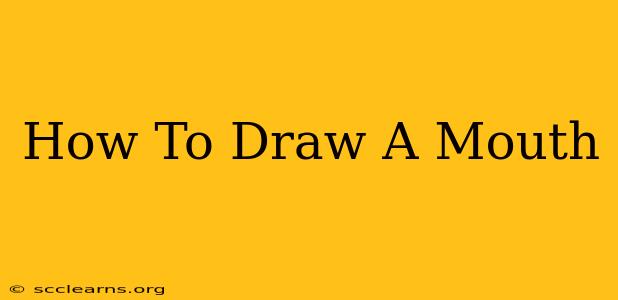Drawing a mouth might seem simple, but achieving a realistic and expressive mouth requires understanding its underlying structure and how different elements interact. This comprehensive guide will walk you through various techniques, from basic shapes to advanced shading, enabling you to draw mouths that truly bring your artwork to life.
Understanding the Anatomy of a Mouth
Before diving into the drawing process, let's lay the groundwork by understanding the key anatomical features of a mouth:
- Lips: The lips are composed of the upper and lower lip, each with its unique shape and texture. The upper lip typically has a cupid's bow, a distinctive curve in the center, while the lower lip is generally fuller and rounder.
- Mouth Corners: The corners of the mouth, also known as the oral commissures, play a crucial role in conveying emotion. Their position significantly impacts the overall expression.
- Philtrum: This is the vertical groove located between the base of the nose and the upper lip. Its presence adds realism and depth to the mouth.
- Teeth and Gums (Optional): Depending on your drawing style, you may want to include teeth and gums for added detail.
Basic Shapes and Techniques for Drawing a Mouth
Let's start with simple shapes to build a foundation for more complex mouth drawings:
1. The Simple Line Method:
Start with a simple horizontal line to represent the mouth opening. Then, add slightly curved lines above and below to shape the upper and lower lips. This provides a basic framework to refine later.
2. The 'M' and 'W' Method:
Use the letter 'M' as a guide for the upper lip, and the letter 'W' for the lower lip. This is a quick and intuitive approach that captures the natural curves of the lips.
3. Using an Oval Shape:
Draw an oval shape and refine its edges to depict the volume and fullness of the lips.
Adding Details and Shading for Realism
Once you've established the basic shape, it's time to add details and shading to enhance the realism of your mouth drawing:
- Highlight and Shadow: Observe how light falls on the lips. Use highlights to emphasize the rounded forms and shadows to create depth and dimension. This helps to bring the mouth to life.
- Lip Lines: Delicate lines can be used to suggest the fine texture of the lips. Be subtle—overdoing it can look unnatural.
- Teeth and Gums (if included): Pay close attention to how teeth are positioned and how the gums are shaped. The subtle nuances in this area are key to a realistic depiction.
- Expression: The position of the mouth corners significantly impacts the perceived emotion. A slightly upward turn suggests happiness, while a downward turn indicates sadness.
Drawing Mouths in Different Positions and Expressions
Practice drawing mouths in various positions and expressions to expand your skillset:
- Smiling: Notice the elevation of the lip corners and the tension around the mouth area.
- Frowning: Observe how the corners turn downwards, and how the upper lip often becomes more prominent.
- Open Mouth: Consider the visible teeth, tongue, and the overall shape changes.
- Talking: Observe the subtle movements and shifts in lip position during conversation.
Practice and Experimentation: The Key to Success
Drawing a convincing mouth takes time and practice. Experiment with different approaches, reference images, and don't be afraid to make mistakes. The more you practice, the more natural and fluid your drawings will become. Remember to observe real-life examples—study photos and videos to better understand the subtle nuances of the mouth. Observe the different ways light interacts with the surface and creates shadows.
By incorporating these techniques and consistently practicing, you'll master the art of drawing realistic and expressive mouths, adding depth and emotion to your artwork. Remember, consistent practice is the key!

